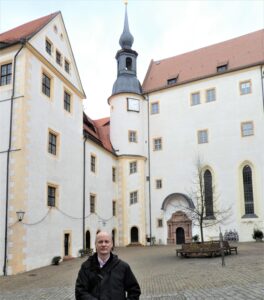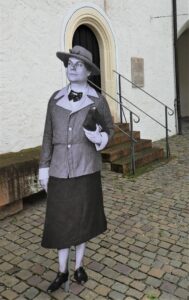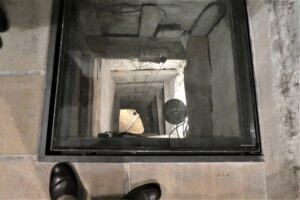a visit and two book reviews.
In November 2021, my wife, Dorothe and I visited Colditz castle. Prior to our visit, I had read the two books reviewed below.
There are three parts to the castle: the historic / museum section, the youth hostel and the music centre. We stayed one night at the youth hostel (for which you can pay for a temporary membership of the German youth hostel association), and the following day we visited the museum and had a tour of the castle (which should be booked in advance) from an excellent English speaking guide. We were told of the history of the castle, with particular focus on the Second World War prisoner escapes. We were shown the French tunnel in the cellar, the chapel with its tunnel underneath, and the attic room including the reconstructed escape glider.
Colditz town is pleasant, with some cafes, shops and restaurants.
We also stayed at Berlin, Leipzig and Dresden, which were all within reasonable travelling distance.
I would also recommend the Escape from Colditz board game which is available in an excellent new edition: https://ospreypublishing.com/escape-from-colditz
Colditz: The Definitive History
Henry Chancellor
Hodder and Stoughton 2001
Henry Chancellor writes well, making this an engaging read and gives a comprehensive in its account of the escape attempts.
Many people naturally feel uncomfortable at the idea of enjoying prisoner of war adventure escape stories. The evils of the holocaust, the extermination and work camps tend to overshadow everything. However, Colditz was an exception. It was a model prisoner of war camp for officers, that was overseen by the Red Cross and the prisoners received Red Cross parcels and letters. The guards were not the SS. If a prisoner escaped and was recaptured they would be put in solitary confinement for a period. They were not shot. They were not tortured. Chancellor explains:
“The Nazis treated their enemies with ruthless brutality: foreigners, dissidents, Jews and other ‘undesirables’ were transported to labour camps or murdered in their millions during the Second World War. These officers […] could easily have suffered the same fate. But the events in Colditz seem to belong to another era – a gentler age when both sides behaved with honour, and adhered to the ‘rules’ of engagement. There was remarkably little animosity between captives and captors – the notice on the guard-house door reminded the Germans that the prisoners were only doing their duty in attempting to escape, and it was the guards’ duty to keep them in.” P.189-190
An example of the ‘fair play’ attitude was in the use of German tools for theatre productions that the prisoners put on for prisoners, guards and locals:
“During the theatre’s peak periods, particularly the spring of 1944, there were new productions every two weeks, all of which required actors, sets and costumes. The Germans encouraged this activity as it kept the prisoners legitimately busy, and as Colditz town had little in the way of entertainment anything the prisoners provided was welcomed. They […] provided powder paint and white lining paper to change the colour of the sets, and also lent the prisoners ‘parole tools’ with which to build them. ‘Every morning I went down to the guardhouse to draw a set of tools in a carpenter’s bag,’ remembers Hugo Ironside, one of the set builders. ‘We told the Germans that these tools would not be used or copied in any way for escaping purposes, and we stuck to that in true Brit fashion. And I don’t think anyone ever misused that promise we made to them. It didn’t seem right somehow.’ […] even if a saw or a chisel was exactly what the prisoners required. They were content to make use of their own escapers’ tools out of gramophone wire, bedsteads, cutlery and anything else they could steal from around the castle.” P.83
Chancellor recounts lots of escape attempts, including one from Lieutenant Pierre Mairesse Lebrun, who had been put in solitary confinement after a failed escape attempt, but was taken one a day for a period of exercise in a pen of high barbed wire:
“Each day Lebrun and his compatriot, Lieutenant Odry, were escorted down to the park by an officer, an NCO and three armed soldiers. The two prisoners were let into the wire enclosure, and left to wander about for an hour. Lebrun’s plan was audacious to the point of stupidity; using Odry as a springboard he would vault over the wire fence and run for the park wall. He knew the guards would fire at him, but it was a calculated risk. […] ‘On the first and second days the Germans looked as if they knew how to shoot […] on the third day, there was one guard wearing thick glasses, I thought to myself, he can’t see very well! […] The other two guards didn’t look like bad chaps. So I whispered to Odry that today was the day.’ […] Odry leaned against the wire and cupped his hands as a stirrup. Lebrun ran towards him, vaulted, and flew clean over the wire. […] Then the shooting started. By the time the Frenchman reached the wall splinters of stone were ricocheting into him, but he was not hit. He ran up and down the base of the wall ‘like a rabbit’ as the sentries, only fifty yards away, tried to pick him off. ‘There were three guards and I had to let them fire their three shots each,’ he recalls. ‘Because I didn’t want to start climbing the wall where I would be a static target.’ Mairesse Lebrun counted the shots until he knew their magazines were empty. As soon as the shooting stopped he leaped at the eight-foot wall. ‘I hoped that in their panic their guards’ hands would be shaking, so it would take them longer to reload.’ […] In a few seconds he was over the wall and crashing through the woods beyond. A hail of bullets ripped into the trees and an off-duty guard set off in pursuit, but Lebrun eluded them.” P.53:
On another occasion, prisoners returning from the exercise park inadvertently foiled an escape attempt of one of their own number:
“‘We were coming back from the walk in the park,’ remembers Kenneth Lockwood. ‘And we passed this lady, perfectly turned out, coming towards us in the opposite direction. Well, nobody bothered about it very much until Brian Paddon looked down and noticed that she’d dropped her watch. So being a gentleman he picked it up and ran after her. And he was trying to give it back to her but she just kept walking along. The guards who were with us saw this scene and then it suddenly occurred to them there shouldn’t be a lady walking down here, so they ran after her. It was indeed no lady.’ It was Lieutenant Boulé, walking out of the camp in his own ingenious disguise. Had it not been for the gallant Brian Paddon, he would have passed out of the camp undiscovered.” P.60
There are some life-size photos around the castle today. One of them is of Lt Boulé, in his disguise, taken by the guards soon after he was captured. This is a photo I took during my visit:
Chancellor also describes the ambitious feat of engineering of the French tunnel. The guards regularly searched the ground floors for tunnel entrances, so the French prisoners created their tunnel entrance 85 feet up at the top of the clock tower, where they accessed a gap between the lining of the wall of the clock tower to descend to ground level. The tunnel then ran under the Chapel:
“Soon, the fat lamps inside the tunnel were replaced with electric lights: three new arrivals – Madin, Vidal and Frédo Guignes – had managed to draw a supply from a switchbox inside the sacristy. […] The French chaplain, Abbé Jean Jean, contrived to spend as many hours as he could in the chapel, so he could act as a lookout; he also had to spend a great deal of time ‘hearing the concessions’ of the three electricians in the sacristy. ‘I can still see Vidal on his knees and Father Jean Jean hearing his confession,’ remembers Guigues. ‘There was a whole jumble of electrical wires lying at their feet, less than a metre away from a German who was apologising for having disturbed their spiritual exercise. All of us received crash courses in the catechism, because of our ‘conversion.’” P.100
Here is a photo I took of one of the shafts of the French tunnel seen through a glass panel of the chapel floor:
Near the end of the book is the poignant account of Lt. Mike Sinclair’s final escape attempt. Sinclair had:
“made nine escape attempts in all, two of them before he even arrived at the castle. By the summer of 1943 he had already escaped from Colditz twice, reaching Cologne and the Dutch border, and on both occasions he slipped away from his captors before being recaught twice more.” p.233
Towards the end of the war he was shot and killed as he ran for the perimeter wall after scaling the barbed wire. He had not sought approval from the escape committee for the attempt, presumably because it was so risky and they would have said no. He had left a note for his friends in case he didn’t make it:
“I take full responsibility. Safe home to all you good chaps.” P.237
They Have Their Exits
Airey Neave
Hodder and Stoughton, 1953.
Airey Neave’s book, originally published only eight years after the war, describes his original capture, his time in Colditz, his escape to through Germany to Switzerland, then on through occupied France and Spain, then from Gibraltar back to England. It also covers his subsequent minor role during the Nuremburg trials.
Neave’s escape was that he had found a route from under the stage in the theatre, on the third floor of the building (in the left of the below photo), that accessed a corridor above the entrance to the courtyard (shown in the centre of the photo), and then into the top of the spiral stair case leading to the guard house, (shown towards the right of the photo).
Neave and Lieutenant Toni Luteyn of the Netherlands East Indies Army, emerged from the guardhouse stairs, dressed as German guards:
“as we marched smartly into the blinding whiteness of the snow under the arc lights. The testing time had come. I strode through the snow trying to look like a Prussian. There stood the sentry […] he saluted promptly, but he stared at us, and as our backs were turned I felt him watching. […] A soldier came towards us from the married quarters. He reached us, stopped and stared deliberately. I hesitated for a moment ready to run, but Luteyn turned on him quickly and in faultless German said crossly, ‘Why do you not salute?’ The soldier gaped. He saluted still looking doubtful” P.91
Neave’s book is a good complement to Chancellors, because it gives a first-hand account of one escape, whilst Chancellor provides the overview.
Both books are enjoyable reads.
Adrian Vincent
January 2022



